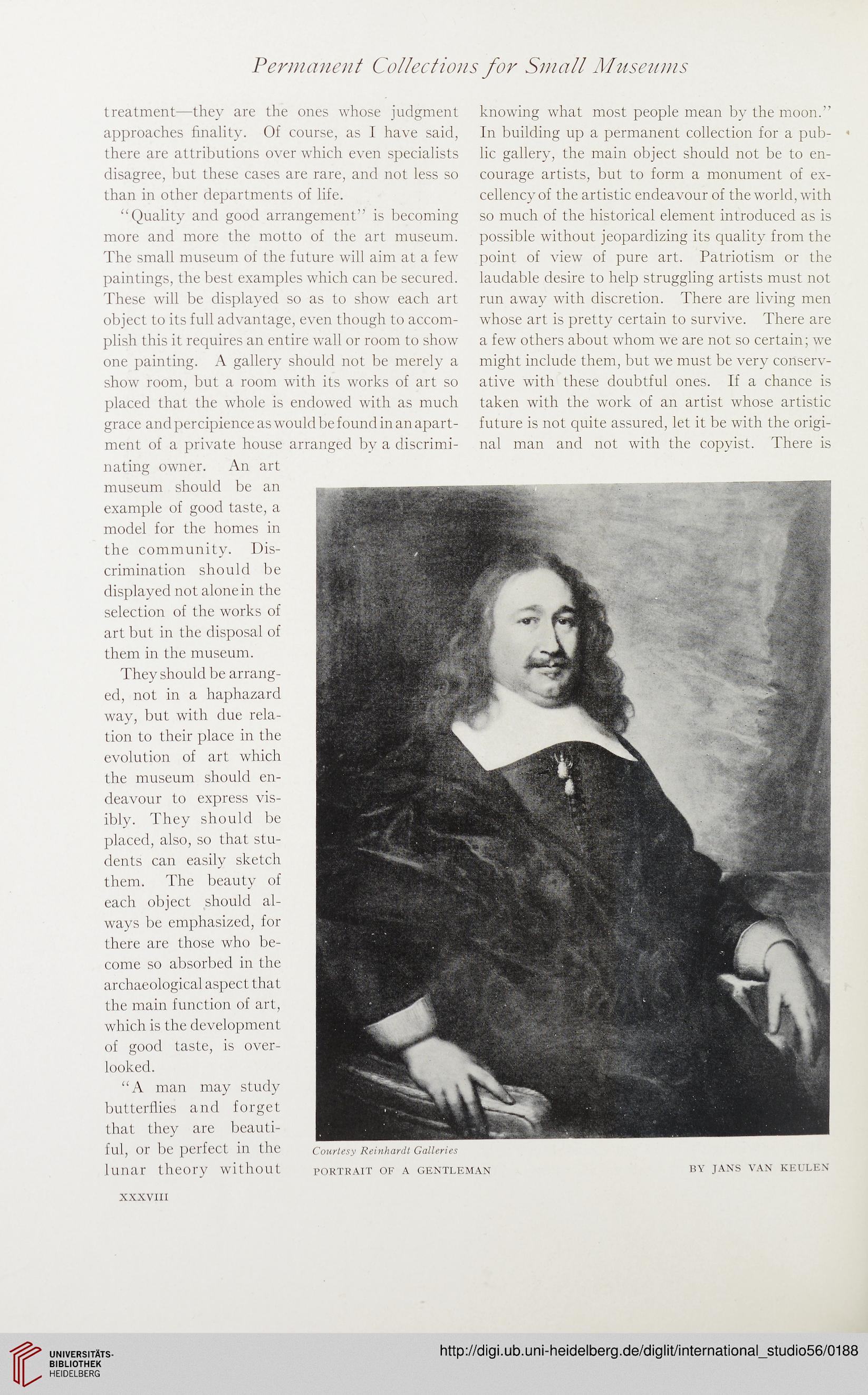Permanent Collections for Small Museums
treatment—they are the ones whose judgment
approaches finality. Of course, as I have said,
there are attributions over which even specialists
disagree, but these cases are rare, and not less so
than in other departments of life.
“Quality and good arrangement” is becoming
more and more the motto of the art museum.
The small museum of the future will aim at a few
paintings, the best examples which can be secured.
These will be displayed so as to show each art
object to its full advantage, even though to accom-
plish this it requires an entire wall or room to show
one painting. A gallery should not be merely a
show room, but a room with its works of art so
placed that the whole is endowed with as much
grace and percipience as would be found in an apart-
ment of a private house arranged by a discrimi-
nating owner. An art
museum should be an
example of good taste, a
model for the homes in
the community. Dis¬
crimination should be
displayed not alone in the
selection of the works of
art but in the disposal of
them in the museum.
They should be arrang¬
ed, not in a haphazard
way, but with due rela¬
tion to their place in the
evolution of art which
the museum should en¬
deavour to express vis¬
ibly. They should be
placed, also, so that stu¬
dents can easily sketch
them. The beauty of
each object should al¬
ways be emphasized, for
there are those who be¬
come so absorbed in the
archaeological aspect that
the main function of art,
which is the development
of good taste, is over¬
looked.
“A man may study
butterflies and forget
that they are beauti¬
ful, or be perfect in the
lunar theory without
knowing what most people mean by the moon.”
In building up a permanent collection for a pub-
lic gallery, the main object should not be to en-
courage artists, but to form a monument of ex-
cellency of the artistic endeavour of the world, with
so much of the historical element introduced as is
possible without jeopardizing its quality from the
point of view of pure art. Patriotism or the
laudable desire to help struggling artists must not
run away with discretion. There are living men
whose art is pretty certain to survive. There are
a few others about whom we are not so certain; we
might include them, but we must be very conserv-
ative with these doubtful ones. If a chance is
taken with the work of an artist whose artistic
future is not quite assured, let it be with the origi-
nal man and not with the copyist. There is
Courtesy Reinhardt Galleries
PORTRAIT OF A GENTLEMAN
XXXVIII
BY JANS VAN KEULEN
treatment—they are the ones whose judgment
approaches finality. Of course, as I have said,
there are attributions over which even specialists
disagree, but these cases are rare, and not less so
than in other departments of life.
“Quality and good arrangement” is becoming
more and more the motto of the art museum.
The small museum of the future will aim at a few
paintings, the best examples which can be secured.
These will be displayed so as to show each art
object to its full advantage, even though to accom-
plish this it requires an entire wall or room to show
one painting. A gallery should not be merely a
show room, but a room with its works of art so
placed that the whole is endowed with as much
grace and percipience as would be found in an apart-
ment of a private house arranged by a discrimi-
nating owner. An art
museum should be an
example of good taste, a
model for the homes in
the community. Dis¬
crimination should be
displayed not alone in the
selection of the works of
art but in the disposal of
them in the museum.
They should be arrang¬
ed, not in a haphazard
way, but with due rela¬
tion to their place in the
evolution of art which
the museum should en¬
deavour to express vis¬
ibly. They should be
placed, also, so that stu¬
dents can easily sketch
them. The beauty of
each object should al¬
ways be emphasized, for
there are those who be¬
come so absorbed in the
archaeological aspect that
the main function of art,
which is the development
of good taste, is over¬
looked.
“A man may study
butterflies and forget
that they are beauti¬
ful, or be perfect in the
lunar theory without
knowing what most people mean by the moon.”
In building up a permanent collection for a pub-
lic gallery, the main object should not be to en-
courage artists, but to form a monument of ex-
cellency of the artistic endeavour of the world, with
so much of the historical element introduced as is
possible without jeopardizing its quality from the
point of view of pure art. Patriotism or the
laudable desire to help struggling artists must not
run away with discretion. There are living men
whose art is pretty certain to survive. There are
a few others about whom we are not so certain; we
might include them, but we must be very conserv-
ative with these doubtful ones. If a chance is
taken with the work of an artist whose artistic
future is not quite assured, let it be with the origi-
nal man and not with the copyist. There is
Courtesy Reinhardt Galleries
PORTRAIT OF A GENTLEMAN
XXXVIII
BY JANS VAN KEULEN




